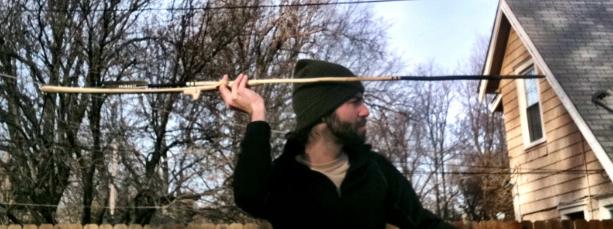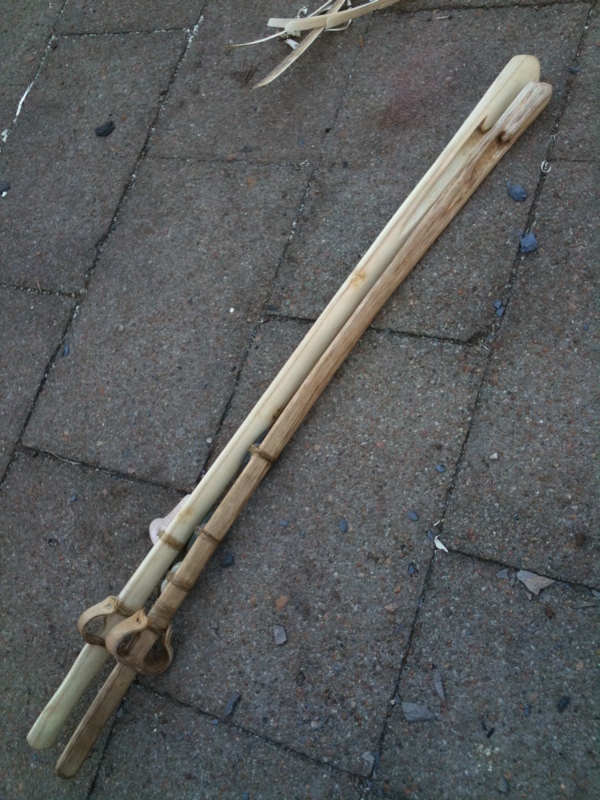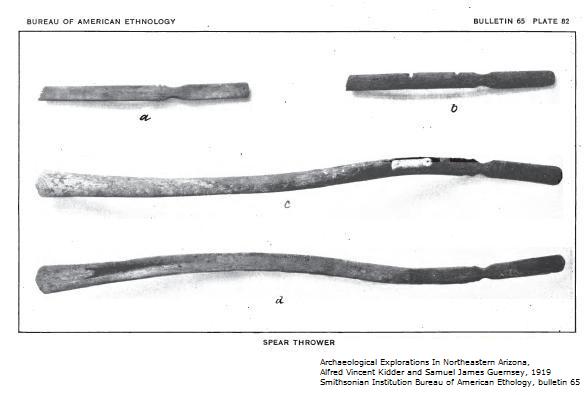The Kinboko Canyon, Burial Cave 1, Cist 10 atlatl
-Justin Garnett, 2011
At the bottom of a slab lined burial cist in Kinboko Canyon, Burial Cave 1, members of the Harvard Peabody expedition overseen by Kidder and Guernsey discovered what was at the time the finest southwest atlatl to be recovered by that institution. The atlatl, laying face-up at the bottom of the cist, was complete, although it was badly deformed. The atlatl had become warped and shaped itself to the bottom of the cist, which was lined with a thick layer of hardened adobe. Upon cutting the atlatl free from the encasing matrix, it was noticed that there lay another object beneath it-this, upon removal, was found to be the atlatl’s weight-a beautifully worked and drilled stone of apparently unique form-no atlatl weight of similar shape has been found in the ensuing years since the atlatl’s discovery in 1915. Two plates from Kidder and Guernsey’s 1919 report are reproduced here as
figures 1-2, as the report has passed into the public domain. The plates were digitized by Google Books. Isotope dating on associated human remains from Cist 10 have produced isotope dates of BC 352 to AD 46, putting this atlatl in the “White Dog Phase” of the Basketmaker II period (Coltrain 2007).
Figure 1: The complete Kinboko Canyon Cave 1, Cist 10 atlatl. Also pictured are handle fragments also recovered from the same site. Note similarity of form.

Figure 2: The weight found in association with the complete atlatl. The form is apparently unique.
At the time of the atlatl’s discovery, there had not yet been any complete Basketmaker atlatl darts recovered and described from diggings in the southwest. Experimental models made at the time were used, and a good drawing of such a model was provided in Kidder and Guernsey’s report. This is shown as figure 3. In this throwing model, the dart is short (Perhaps a bit too short) and grip is provided by the following method: the third and fourth
fingers along with the base of the thumb grip the handle against the palm, and the dart is placed between the first and second fingers, being additionally steadied by the thumb-tip. This model was claimed in the 1919 report to have been arrived at by replication and experimentation, although (unfortunately) no details about the nature of the replicated gear and their use was offered. The proposed grip is indeed viable, although the handle
on such weighted basketmaker atlatls is best used in conjunction with a loose grip, rather than pressing the handle firmly against the palm, and with the fingers inserted less deeply into the loops. Furthermore, the size and shape of intact loops on other Basketmaker atlatls do not cater to this gripping method, but rather fit perfectly around the first (distal) and second (intermediate) phalanges of the index and middle fingers, rather than to the base of the third (proximal) phalanges as seen in Kidder and Guernsey’s drawing.

Figure 3: Grip method as proposed by Kidder and Guernsey, 1919.
In summer of 2010, I had the pleasure of examining this artifact personally, in order to obtain the necessary measurements for precise replication. These measurements are given in table 1. The material of the atlatl is a white oak group oak (This is a large family of trees, representing a great many varied species), likely Gambel oak (Quercus gambellii) and the material of the stone is not 100% positively identified. The stone is located ~18cm distal from the handle tip. The weight of the stone is given by Kidder and Guernsey at 1 oz-I did not personally weigh the stone.

Table 1: Measurements of Kinboko Canyon, Burial Cave 1, Cist 10 atlatl.
I made my replica (Figures 4-5) in white ash (Fraxinus americana) which has a density overlapping that of Gambel oak, making it a good candidate by proxy. The finger loops of the original were missing, and were speculatively reconstructed in 2-ply deer hide, using artifacts from White Dog Cave as templates. The loops and weight, which was ground from alabaster to the proper mass, were then attached with strips of hide-glue soaked sinew. The binding passes through the biconical hole drilled in the weight, and around the shaft of the weapon. A cross siezing was then wound around the base of the first siezing. Upon drying and constriction, this binding proved sufficient to hold the stone solidly to the shaft, however upon swinging, the stone tilted slightly, allowing the distal end of the stone to tap against the wooden shaft, like a telegraph transmitter. This produced an audible click at the end of the swing. This condition was corrected by the positioning of a drop of hide glue beneath the stone. This dried in place to form a “wedge” preventing further play of the stone, and corrected the clicking issue.

Figure 4: Replica of Kinboko Canyon, Cave 1, Cist 10 atlatl.

Figure 5: Kinboko Canyon, Cave 1, Cist 10 atlatl replica held with a “Floating grip” and short, basketmaker dart.
Despite an initially unwieldy appearance, the atlatl is very well handling. When throwing replica darts based on specimens from White Dog Cave, the balance point of the system falls above the fingerloops. This condition of exceptional balance allows easy throwing with a “Floating grip”. The Kinboko Canyon atlatl is very similar in overall dimension to the White Dog Cave, Cist 27 atlatl, if a bit on the wider side. This is interesting, when one considers the two sites are only separated by ~5 miles, both being located in Marsh Pass, just west of Kayenta Arizona. In time they are very similar as well-The dates of the sites overlap-Kinboko Canyon, Cist 10 human remains furnished isotope dates of BC 352 to AD 46, while human material from White Dog Cave, Cist 27 produced dates of BC 405 to BC 204 (Coltrain, 2007). Therefore there is a potential of 53 years of overlap between the two graves and the atlatls found within.

Figure 6: Kinboko Canyon, Cave 1, Cist 10 atlatl replica (left) laid alongside White Dog Cave Cist 27 atlatl replica (right), to illustrate similarity of form.
References:
Alfred Vincent Kidder and Samuel James Guernsey
“Archaeological excavations in Northeastern Arizona”, Smithsonian Institution Bureau of American Ethnology, bulletin 65, 1919
Joan Brenner Coltrain, Joel C. Janetski and Shawn W. Carlyle
“The stable and radio-isotope chemistry of western basketmaker burials: implications for early puebloan diets and origins”, American Antiquity, 72(2), 2007, pp. 301–321
The author would like to thank Susan Haskell and the rest of the staff of the Harvard Peabody Musuem, as well as Jeremy Garnett for his assistance in collecting data.



Great site, very helpful information. I confused about your measurements for the width at the Finger Notch – does the 7.02 cm include the finger loops.
Thanks, glad you like the site. Thanks for pointing out the error. The measurement shown o nthat version of the table was the thickness (not the width) and was in mm, not cm. Oops. I’ve replaced that information, and included the actual width between the finger notches.